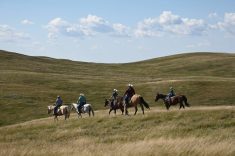The new year started off with a bounce in fed cattle prices with Alberta packer purchases in the range of $172 to $174, up from the December lows of $160.
While fed cattle wholesale beef markets were declining throughout the fall period, retailers were holding up beef prices. However, during the first half of January, grocers were featuring beef products, which alleviated the backlog in the supply chain. Wholesale beef prices have experienced a small recovery off the lows and packing margins are now in favourable territory.
Feeder cattle prices also recovered with the rise in the fed cattle market. In southern Alberta, steers weighing 800 pounds surged from $185 in late December to $212 by mid-January. Feedlot operators have breakevens for the May pen closeouts near $173 and the ability to lock in a profitable margin resulted in a surge of demand for replacements. The fed and feeder cattle markets have stabilized but there are fair amount of risks moving forward so the volatility may not be over.
Read Also

Harvest wraps up and fall work begins
At the Eppich famly ranch in western Saskatchewan, the fall harvest was successful with few breakdowns, cows and calves have been sorted and a new tractor has arrived
U.S. cattle on feed inventories as of Dec. 1 were 10.8 million ahead, about the same as Dec. 1 of 2014. November placements were only 1.6 million, which was a record low but we need to see subsequent months to alter on-feed projections. Heavier carcass weights is expected to cause a sharp 300-million pound year-over-year increase in beef first quarter beef production followed by a similar increase in the second quarter. The contraction phase in the beef cycle is over and I’m expecting growing production levels through 2016 and into 2017.
Production up
The U.S. 2014 calf crop was 170,000 head larger than in 2013; I’m expecting the 2015 calf crop to be 0.7 million head larger than in 2014. This will be a significant change to the supply equation in the latter half of 2016 and into 2017 as market adjusts for greater feeder cattle placements. I’m forecasting 2017 beef production to reach upwards of 25.5 billion pounds.
Canadian beef production for 2015 reached 959,177 mt, down three per cent from 2014. Exports to the U.S. of fresh and chilled beef cuts were up four per cent and latest data has total exports up one per cent. The recession in Canada took a toll on beef consumption in 2015, especially with the record-high prices. During 2016, we should see an increase in domestic consumption as retail prices come back closer to five-year average levels. Cattle on feed inventories in Alberta and Saskatchewan have been running two per cent above year-ago levels and this trend will likely continue due to lower feeder cattle exports to the U.S.
Beef demand remains a large uncertainty for 2016 as the economic environment continues to erode in Canada and stagnate in the U.S. In early January, many grocers were featuring ground beef 30 per cent off regular price while other higher-end steaks were as much as 50 per cent off. January and February are periods of seasonal low food expenditures but the decrease in retail beef prices may help sustain wholesale and fed cattle prices. The U.S. economy is vulnerable to slower growth in China and this uncertainty is not over. China may experience a period of slow or negative growth after years of double-digit expansion. U.S. per capita beef consumption needs to rise to absorb the larger supplies, but this will only occur through lower retail and restaurant prices compared to 2015.
Recession pressures
The Canadian dollar continues to deteriorate, dipping to 13-year lows in mid January. There appears to be no end to the recessionary environment in Canada with historically low commodity prices, mainly crude oil and metals. Unemployment in the private sector continues to grow and governments run larger than projected deficits in 2016. The low Canadian dollar will continue to support fed and feeder cattle prices through 2016.
The ability of feedlots to lock in a profitable margin for the spring period caused a recovery in the feeder cattle market in January. I’m expecting Canadian fed cattle prices to remain relatively flat during the first quarter and slightly weaker in the second quarter. Feedlots experienced significant equity erosion in the final quarter of 2015 so the recovery in fed cattle prices was a bright New Year’s gift. Further upside in the feeder market would cause feedlot margins to drop back into negative territory. I encourage cow-calf producers to be realistic with their price expectations. This recent recovery is not a return to the historical highs but an adjustment in line with the fed cattle market. The larger U.S. calf crop along with soft margins in the feedlot sector will limit further upside.
















